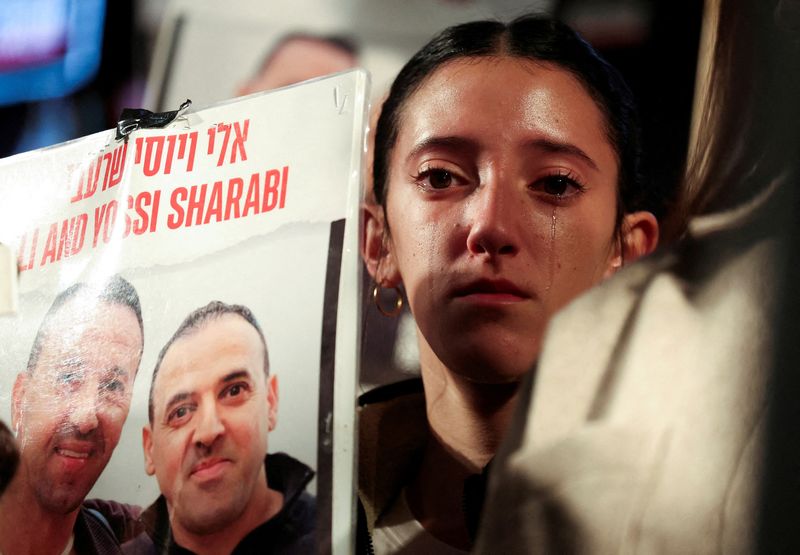
By Maayan Lubell and Nidal al-Mughrabi
JERUSALEM/CAIRO (Reuters) – A cease-fire in Gaza between Israel and Hamas is set to begin on Sunday morning with a hostage release to follow hours later, paving the way for a possible end to a 15-month war that has transformed the Middle East.
The agreement followed months of on-off negotiations brokered by Egypt, Qatar and the United States, and came ahead of the January 20 inauguration of US President-elect Donald Trump.
The three-phase ceasefire will begin at 0630 GMT on Sunday.
Its first phase will last six weeks, during which 33 of the remaining 98 captives – women, children, men over 50, the sick and wounded – will be released in exchange for nearly 2,000 prisoners and detainees. in Palestine.
It included 737 men, women and teenage prisoners, some of whom were members of militant groups convicted of attacks that killed dozens of Israelis, as well as hundreds of Palestinians from Gaza has been in prison since the start of the war.
Three female captives are expected to be released on Sunday afternoon by the Red Cross, in exchange for 30 prisoners each.
After Sunday’s hostage release, US lead negotiator Brett McGurk said the deal called for four more female hostages to be released after seven days, followed by the release of three additional hostages each seven days after that.
US President Joe Biden’s team is working with Trump’s Middle East ambassador Steve Witkoff to push the deal over the line.
As his inauguration approaches, Trump has repeated his demand that a deal be made quickly, repeatedly warning that there will be “hell to pay” if the hostages are not released.
POST-WAR GAZA?
But what will happen next in Gaza remains unclear without a comprehensive agreement on the enclave’s postwar future, which will require billions of dollars and years of work to rebuild.
And although the stated goal of the ceasefire was to end the war completely, it was easily broken.
Hamas, which has controlled Gaza for nearly two decades, has survived despite losing its top leadership and thousands of fighters.
Israel has vowed it will not allow Hamas to return to power and cleared large swathes of land inside Gaza, in a move widely seen as a step towards creating a buffer zone that would allow its troops to act freely against enclave threats.
In Israel, the return of the captives may assuage some of the public anger against Prime Minister Benjamin Netanyahu and his right-wing government over the Oct. 7 security failure that led to the deadliest single day in the country’s history.
But his government’s hardliners have already threatened to quit if the war against Hamas does not continue, leaving him squeezed between Washington’s desire to end the war, and his far-right political allies at home.
And if the war continues, more hostages will be left behind in Gaza.
MIDDLEAST SHOCKWAVES
Outside Gaza, the war has sent shockwaves across the region, sparking a war with the Tehran-backed Lebanese Hezbollah movement and bringing Israel into direct conflict with its arch-nemesis Iran for the first time.
Over a year ago, the Middle East changed. Iran, which has spent billions building a network of militant groups around Israel, saw its “Axis of Resistance” destroyed and was unable to inflict more than minor damage on Israel in two major attacks. of missiles.
Hezbollah, whose vast missile arsenal was once seen as Israel’s greatest threat, has been subdued, with its top leadership killed and most of its missiles and military infrastructure destroyed.
Afterward, the decades-old Assad regime in Syria was toppled, removing another major Iranian ally and leaving Israel’s military effectively unchallenged in the region.
But on the diplomatic front, Israel faces anger and isolation over the death and destruction in Gaza.
Netanyahu faces an International Criminal Court arrest warrant on allegations of war crimes and separate accusations of genocide by the International Court of Justice.
Israel reacted with anger to both cases, dismissing the charges as politically motivated and accusing South Africa, which brought the original case to the ICJ as well as the countries that participated in it, of antisemitism.
The war was triggered by Hamas’ October 7, 2023, attack in southern Israel in which 1,200 people died and more than 250 were taken hostage, according to Israeli tallies. More than 400 Israeli soldiers have died in the fighting in Gaza since then.

Israel’s 15-month campaign in Gaza has killed nearly 47,000 Palestinians, according to figures from Gaza’s health ministry, which does not distinguish between combatants and civilians, and has left pig- ot coastal enclave that is a desert of ruins.
Health officials said most of the dead were civilians. Israel says more than a third are fighters.







